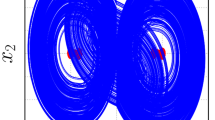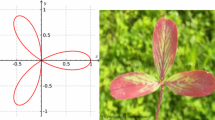Abstract
Chaotic signals and systems are widely used in image encryption, secure communications, weak signal detection, and radar systems. Many researchers have focused in recent years on the development of systems with an infinite number of coexisting chaotic attractors. We propose some approaches in this work to the generation of self-reproducing systems with an infinite number of coexisting self-excited or hidden chaotic attractors with the same Lyapunov exponents based on mathematical models of Lurie systems. The proposed approach makes it possible to generate extremely multistable systems using numerous known examples of the existence of chaotic attractors in Lurie systems without resorting to an exhaustive computer search. We illustrate the proposed methods by constructing extremely multistable systems with 1-D and 2-D grids of hidden chaotic attractors using the generalized Chua system, in which hidden attractors were first discovered by G.A. Leonov and N.V. Kuznetsov.







Similar content being viewed by others
REFERENCES
Z. H. Guan, F. Huang, and W. Guan, “Chaos-based image encryption algorithm,” Phys. Lett. A 346, 153–157 (2005).
T. Gao and Z. Chen, “A new image encryption algorithm based on hyper-chaos,” Phys. Lett. A 372, 394–400 (2008).
E. Y. Xie, C. Li, S. Yu, and J. Lu, “On the cryptanalysis of Fridrich’s chaotic image encryption scheme,” Signal Process. 132, 150–154 (2017).
S. Wang, J. Kuang, J. Li, Y. Luo, H. Lu, and G. Hu, “Chaos-based secure communications in a large community,” Phys. Rev. E 66, 065202R (2012).
G. Wang and S. He, “A quantitative study on detection and estimation of weak signals by using chaotic Duffing oscillators,” IEEE Trans. Circuits Syst.-I: Fund. Theor. Appl. 50, 945–953 (2003).
Z. Liu, X. H. Zhu, W. Hu, and F. Jiang, “Principles of chaotic signal radar,” Int. J. Bifurcation Chaos 17, 1735 (2007).
G. A. Leonov, “Efficient methods for the search for periodic oscillations in dynamical systems,” Prikl. Mat. Mekh. 74 (1), 37–49 (2010).
V. O. Bragin, V. I. Vagaitsev, N. V. Kuznetsov, and G. A. Leonov, “Algorithms for finding hidden oscillations in nonlinear systems. The Aizerman and Kalman conjectures and Chua’s circuits,” J. Comput. Syst. Sci. Int. 50, 511–543 (2011).
G. A. Leonov, N. V. Kuznetsov, and V. I. Vagaitsev, “Localization of hidden Chua’s attractors,” Phys. Lett. A 375, 2230–2233 (2011).
D. Dudkowski, S. Jafari, T. Kapitaniak, N. V. Kuznetsov, G. A. Leonov, and A. Prasad, “Hidden attractors in dynamical systems,” Phys. Rep. 637, 1–50 (2016).
I. M. Burkin and N. K. Nguen, “Analytical-numerical methods of finding hidden oscillations in multidimensional dynamical systems,” Differ. Equations 50, 1695–1717 (2014).
I. M. Burkin, “Hidden attractors of some multistable systems with infinite number of equilibria,” Chebyshevskiy Sb. 18 (4), 18–33 (2017).
C. Li, J. C. Sprott, W. Hu, and Y. Xu, “Infinite multistability in a self-reproducing chaotic system,” Int. J. Bifurcation Chaos 27, 1750160 (2017).
C. Li, J. C. Sprott, and Y. Mei, “An infinite 2-D lattice of strange attractors,” Nonlinear Dyn. 89, 2629–2639 (2017).
C. Li, J. C. Sprott, T. Kapitaniak, and T. Lu, “Infinite lattice of hyperchaotic strange attractors,” Chaos, Solitons Fractals 109, 76–82 (2018).
C. Li, W. J. Thio, J. C. Sprott, H. H. C. Iu, and Y. Xu, “Constructing infinitely many attractors in a programmable chaotic circuit,” IEEE Access 6, 29003 (2018).
G. A. Leonov, Control Theory (St.-Peterb. Gos. Univ., St. Petersburg, 2006) [in Russian].
Author information
Authors and Affiliations
Corresponding authors
Additional information
Translated by O. Pismenov
About this article
Cite this article
Burkin, I.M., Kuznetsova, O.I. Generation of Extremely Multistable Systems Based on Lurie Systems. Vestnik St.Petersb. Univ.Math. 52, 342–348 (2019). https://doi.org/10.1134/S1063454119040034
Received:
Revised:
Accepted:
Published:
Issue Date:
DOI: https://doi.org/10.1134/S1063454119040034




